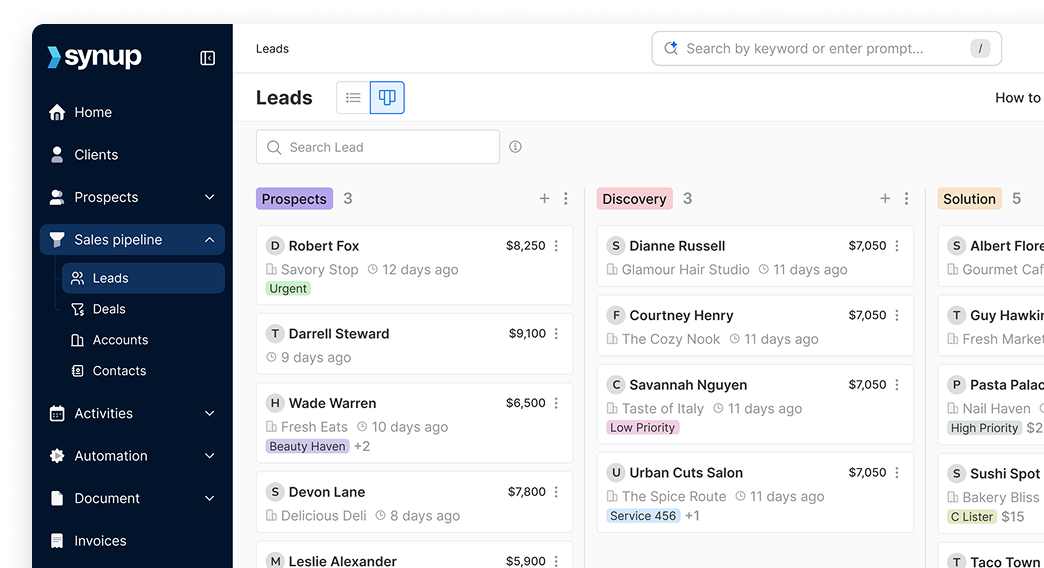On-Page SEO Checklist To Rank Higher In 2025
Read our on-page SEO checklist to learn which tasks to prioritze for the continuous success of your website.
Many websites lose traffic and also potential customers as a result of poor on-page optimization. And this can be prevented by simply optimizing your web pages for search engines regularly.
As search algorithms evolve continuously and are subject to change with time, using unique on-page SEO practices tailored to every location and target keyword becomes necessary for businesses. This is where a structured checklist can be useful.
All the optimizations you do on your website directly affect the way search engines see and rank your pages. It’s also the basis for on-page SEO.
On-page SEO’s primary components include page titles, meta descriptions, headings, internal linking structure, and the content. Although it can appear complicated, breaking it down into some specific tasks makes it much easier. This checklist for on-page SEO ensures that nothing falls through the cracks as you are optimizing your new or existing site.
Why You Need an On-Page SEO Checklist for a Successful Website
Simply put, on-page SEO involves all the elements on your website that impact how search engines understand and index your pages. Here are five important reasons for using a structured checklist for your on-page optimization efforts:
- Keeps you focused on priority tasks. A checklist prevents you from forgetting key areas or getting sidetracked by less important optimizations.
- Ensures comprehensive optimization. It's easy to focus on one or two on-page factors and neglect others equally important to search engines. A checklist covers all the bases.
- Provides accountability. The completion of tasks makes it easy to see if you are progressing and what needs to be focused on to reach your SEO objectives.
- Streamlines collaboration. In case there are several parties involved, including freelancers or agencies, a checklist establishes the standards for expectations and deliverables.
- Serves as an audit tool. Frequent review of the checklist ensures that your site remains optimized over time as the search algorithms change. It also sets up your website for technical SEO audits.
Does this shed light on why it is essential to build an on-page SEO checklist? To start optimizing your site for improved search visibility, look at this step-by-step checklist below.
On-Page SEO Checklist: 11 Tasks To Tick And Rank Higher In Search Engines
1. Identifying and targeting your core keywords and topics
On-page optimization is heavily dependent on selecting the right keywords. Begin by generating a list of all the major terms that your ideal customer may enter when looking for information regarding your business. A simple step-by-step guide to generate keywords include:

1. Competitive analysis and site audit:
To determine which phrases your competitors are ranking for, audit the top 10 search results for each of your target keywords. Also, notice underrepresented keywords where you can distinguish yourself. Conduct an audit of your site to determine what pages currently exist and check for any potential gaps.
2. Keyword research tools:
It is recommended to look for high-volume commercial keywords about your niche through keyword research tools such as Google Keyword Planner, SEMrush, Ahrefs Keywords Explorer, or Answer The Public. Tools may offer many related long-tail keywords, monthly search numbers, and difficulty scores.
3. Customer surveys and support tickets:
Use the tickets and customer messages to identify the words customers use when they are asking questions or describing any issues. Alternatively, you could also ask the customers for their common search terms in a brief survey.
After you have an all-inclusive list, it’s time to evaluate and rank. Upload the keywords from your research tools into a spreadsheet. Columns to include are:
- Keyword phrase
- Estimated monthly searches
- Competition/difficulty score
- Customer intent (informational, commercial, navigational)
- Potential pages to target keyword
Use the traffic and competitiveness data to identify your top 10-15 seed keywords with mid-range difficulty that are most relevant to your goals. These will be optimized first.
Then identify related long-tail keywords with lower search volumes for supporting content. Group similar keywords into logical categories representing primary topics on your site, such as "SEO content checklist" and "SEO optimization checklist."
Tracking your keywords over time is also important. Use Google Search Console to monitor rankings and impressions for your seed keywords. This will reveal progress from optimizations as well as new opportunities over time as search patterns change.
With a comprehensive keyword list segmented into categories, you now have a foundation for focused on-page optimization and structured site architecture.
2. Optimizing Title Tags for Both SERP and Users
Crafting compelling page titles that clearly communicate what each page is about improves both SEO and user experience. Page titles appear in search results snippets and browser tabs, so make them magnetic. Include the primary keyword and keep characters under 60 for mobile friendliness. Some best practices include:

- For the homepage, include your brand/business name followed by a descriptive keyword-rich call-to-action. Internally link category/product pages, including the brand and page topic, and relevant keyword.
- Create unique, highly optimized titles for important pages such as service or product pages. Use the focus keyword at the beginning followed by additional context. For example, a title for a page about "seo optimization checklist" may be "SEO Optimization Checklist: The Essential 7-Step On-Page Checklist".
- Google's algorithms favor relevancy, so your title should match the user's search query intent. Test titles in Google to ensure they trigger relevant snippets for target phrases. Generic titles lacking keywords may not rank.
- Keep titles compelling yet concise. Long titles that wrap in search results negatively impact click-through rates (CTR). Consider splitting lengthy value propositions across the snippet vs title. CTR is a ranking factor.
- Track title field usage across your pages in Google Search Console. Titles appearing blank for submitted URLs need updating. Regularly A/B test variations to optimize click-through performance from search. Configure XML sitemaps and submit them to GSC.
- Optimizing titles as described improves both usability and discoverability on search engines. Users know instantly what each page delivers from the title alone.
3. Header Tags & Subheadings: H1, H2, H3, H4 and How to use them
Proper use of header tags is important for both users scanning your content and search engine crawlers parsing page structure and keyword relevance. Here's a guideline on utilizing each header type:

- H1 Tag:
The <H1> tag should be used only once per page as the main headline summarizing the topic. It’s often the same as your page title. For a page about "seo content checklist," the H1 may be "The Essential SEO Content Checklist".
- H2 Tags:
Use <H2> tags to segment your content into clear sub-sections or chapters, usually 2-4 per page. On a long "SEO optimization checklist" guide, H2s could label sections like "On-Page Factors" or "Content Optimization Tips".
- H3 Tags:
Get more specific with <H3> tags, using them to introduce paragraphs or bullet point lists. For a page about "website seo checklist," H3s could have points like "Site Architecture Audit" or "Technical SEO Checkup".
- H4 Tags and Lower:
Use <H4> and lower tags sparingly for supplementary points not worthy of their section. Generally, avoid using more than H3 tags unless your content truly warrants deeper nesting.
Consistency and readability are important when applying header tags on pages. Stick to the H1->H2->H3 hierarchical structure as intended to maintain the flow for users scanning pages as well as search engines crawling content.
4. Optimizing Meta Descriptions for Clicks
The meta description tag provides a snippet in search results summarizing page content and enticing clicks. Make sure to optimize these for usability and search relevance. Here are some best practices:

- Meta descriptions should be unique to each page and contain the primary keyword along with a call-to-action. For example, a page about "free seo checklist" may read "The Definitive Free SEO Checklist - 17 Essential Tasks to Boost Your Site's Search Rankings."
- Aim for approximately 155 characters including spaces to ensure that the complete description shows. Longer than that will wrap in results. Describe top benefits, not just content recaps.
- Test meta descriptions in search results to see which ones generate the most clicks. A/B test variations for your top pages. Descriptions triggering clicks will positively impact rankings.
- Use the keyword density and context guidelines applied to on-page content. Descriptions containing natural, readable sentences perform better than keyword-stuffed ones. When linking between pages, make sure that the included anchor text clearly describes the content on the linked page.
- One of the ranking signals that search engines measure is click-through in SERPs, which can be improved with optimal meta descriptions. Always describe your value propositions that truly aim at converting visitors into potential leads.
5. Writing SEO-friendly URLs
To achieve higher click-through rates from search engines and internal site navigation, it is essential to optimize URLs for both usability and SEO. Some best practices include:

Use descriptive keywords in the URL path:
For instance, "yourdomain.com/seo-on-site-checklist" has much better SEO optimization than a rather simple URL such as checklist123.html. If the keyword URL is already taken, then target long-tail phrases.
Keep URLs short, simple, and lowercase:
Long and complicated URLs are unattractive, and users don't like to read about or share them with others. If it is possible, use hyphens to separate the keywords instead of underscores or numbers.
Avoid unnecessary URL parameters:
Dynamic URLs with redundant parameters and a session ID should be minimized by using URL rewriting where it is possible.
Configure 301 redirects:
If you need to change URLs, set up 301 permanent redirects from the old URL to the new one to pass along link juice and avoid duplicate content penalties.
Implement URL structure changes gradually:
Make large URL structure changes gradually rather than doing a sudden site-wide redirect to avoid potential ranking drops or unnecessary duplicate content issues.
Write SEO-optimized URLs tailored to your content and site architecture needs. Proper implementation supports both usability and discoverability.
6. Using Core Keywords in Content
On-page text is your most valuable optimization asset. Use your researched keywords naturally throughout your pages as follows:

- Work keywords organically into your first paragraph, subheading, or opening sentence to "tell Google" the topic. For a page about "SEO setup checklist," work that phrase in early.
- Scatter keywords 2-3 more times throughout your content, and vary placement by also including them in body paragraphs, links, image alt text. Space them out at a natural density of 0.5-2% of total words.
- Include keywords in internal linking anchors between your pages to define relationships for crawlers. For pages on the "website SEO checklist", link accordingly.
- Use keyword variations you've researched as related terms, but don't over-optimize at the cost of readability or engagement. Keep users as the priority.
Proper keyword placement optimizes your content for readers and how search engines understand page topics and relations. Always write for readers first and use keywords naturally without over-stuffing.
7. Content Quality Check
While optimizing on-page technical factors is important, high-quality content that solves problems is key. Here are some good tips:

- Make pages easy to read with short paragraphs of 3-5 sentences each and clear headings. Use punctuation and formatting that is easy to read.
- For crucial topics, cover them in depth with a minimum of 1800 words per page. Discuss the topic in detail and address the common queries posed by the users as well as the problems they face.
- In order to receive the links from others, you should establish connections with reliable sources. Incorporate relevant and carefully selected items such as images, videos, and code snippets that improve the experience.
- Get feedback and find out how many people are using your page. Find out from which pages people leave, and how many they scroll and finish. Improve constantly to assist the users and search intent.
People who find value will remain active on your website, connect, and share it. This builds endorsements and improves your trust for search results. Keep high standards for helpful, innovative content.
8. Optimizing Internal Links
Proper internal linking is crucial for supporting users as they navigate your site, while also informing search engines about the importance and relationships between pages. Let's dive into the details:

Conduct an internal link audit -
Use SEO tools like Screaming Frog, DeepCrawl, or Sitebulb to analyze all internal links across your site as well as find broken links. This will reveal opportunities to add new relevant links, as well as outdated/broken links that need fixing.
Plan your information architecture -
On paper, map how topics relate to each other in a hierarchy. Decide which concepts should be parent/child pages based on importance and typical user paths. Link categories and taxonomies at the top.
Prioritize important pages -
Focus first on linking money pages and top-level categories to the tier below them. Important pages like the homepage should link out more than they receive links.
Keywords in linking text -
Internally link-optimized anchor text like "SEO setup checklist" between relevant pages. Avoid vague text like "click here" that doesn't imply relationships.
Natural placement -
Weave new links seamlessly into body paragraphs where they make logical sense conversationally rather than stuffing them all at the bottom. Space them out.
Testing technique -
A/B test alternative anchor texts to compare which generates more clicks through analytics. Adapt accordingly based on user behavior.
Link to latest/relevant content -
Within articles, link to other new/topical pages that may interest readers more than dated ones. Dynamically update links over time.
Structure over hours/pages -
Focus on page structure/navigation first before worrying about sheer link volume that doesn't follow a natural hierarchy or flow.
Cross-link sidebars/footers -
These are good places to suggest related reading through links not embedded in the flow.
With thorough linking analysis, strategy, and testing, you can provide value to both users and search engines through an intuitive internal link network optimized for end-to-end discoverability.
9. Optimizing Images for SEO & User Experience:
Images are a powerful way to enrich your content and engage users, but they also play a role in SEO. Best practices include:

- Selection:
Choose images purposefully. They should relate directly to surrounding text and enhance comprehension. Stock photos come across as impersonal, so take your own using a high-quality camera or find Creative Commons images from sites like Unsplash. Select level images for a uniform aesthetic.
- Sizing:
Size photos appropriately for each placement. Above the fold, desktop images should max out around 1200px width for snappier load speeds. Smaller images load faster but lose impact, so size is based on surrounding copy length. For mobile, scale images down using responsive design. Don't disproportionately enlarge images at different breakpoints.
- File Type & Compression:
Save images as JPEGs for photos and PNGs for graphics. JPEG is best for large photos due to smaller file sizes with negligible quality loss. Compress JPEGs heavily in an optimizer like TinyPNG or Compressor.io without compromising quality. For the web, target file sizes are under 100kB each.
- Alternative Text:
In the <img> tag, include optimized ALT text describing the visual for vision-impaired users and search engines. Keep ALT text around 100 characters concisely articulating the topic and focus keywords. For decorative images where text doesn’t add value, use ALT="". Avoid generic text like "Image" that doesn’t convey useful context.
- Image Captions:
Add <figure> and <figcaption> elements beneath related photos to provide context reinforcing your key messages and SEO terms. Keep captions 50-90 words maximum. Link captions back to relevant internal pages for user-friendly cross-linking and semantic signals. Style captions with CSS for visual consistency.
- Image Optimization:
Use the image optimization plugin in your CMS during upload to automate compression and optimize file names/ALT text based on your templates and desired specs. This saves work and enforces standards. Integrate with your photo management workflow.
- Tracking & Improvement:
Monitor engagement metrics and search console data to see which images drive the most clicks, time on page, and conversions. This reveals what types of visuals work best so you know which themes/topics require new photos. Continuously improve your image library based on data.
10. Mastering Keywords with Internal Links
Thoughtful internal linking enables both readers and search engines to intuitively navigate your site through context clues. Let's review best practices:

- For important top-level pages, include optimized headings using your primary target keywords. For example, a page about "SEO content writing tips" may have an H1 "<Keyword Target>: SEO Content Writing Tips to Boost Google Rankings".
- Internally link secondary and long-tail keyword variations between relevant subpages. A page about "blog SEO tips" could link phrases like "optimizing blog posts for search engines".
- Use keyword strings in your anchor text naturally wherever logical flow allows. A section discussing "keyword research methods" may link that exact phrase to a dedicated resource page.
- Category and taxonomy page headings should also double as anchor text opportunities to associated landing pages. For example, an "SEO Guides" page would link that way to a related article archive.
- Measure click-through rates on keywords linked between pages using analytics. Where CTR is low, test alternative anchor text phrasings through A/B or multivariate testing.
- Regular audits ensure all text remains hyperlinked properly. Check for outdated, non-keyword optimized, or broken internal links needing to be repaired. Fix issues promptly.
Leveraging internal linking strengthens on-page relevance for both visitors and Google's semantic understanding. Keep refining your approach over time.
11. Implement Schema Markup
Scheme markup is structured data that can be offered by businesses and also websites to search engines as well as other applications. This helps search engines to understand what is contained in a particular page and also how it relates to another.

Using the schema tells search engines what type of entities can be found on a page as well as which ones they serve. Many types of schema markup can serve on a website depending upon the different content variants.
Here are some of the key types of schema markup to consider implementing on your website:
- Product schema: In the case of online selling, use product schema to deem that search engines know what products you are selling. It comprises several aspects including the name of a product, pictures, photos, cost, and information.
- Local business schema: Local business schema displays a lot of information, such as the company name, address, telephone number, and more, for companies that have their physical locations like the service industry or restaurants.
- Recipe schema: For recipe sites, the information such as the name of ingredients used and also how to prepare them are provided by using ingredient recipes schema, which helps search engines and readers understand easily.
- Article schema: Almost all the sites have a large number of articles or blog entries. The article schema provides a lot of information about the articles, including the author title, published or modified date description, and others.
- FAQ (Frequently Asked Questions) page schema: For pages collecting common questions and answers, FAQ page schema allows indicating questions and corresponding answers on the page.
-Software application schema: For websites describing software apps, this schema provides details such as application name, operating systems supported, version, ratings, etc.
- Person schema: Use the author/people pages for more details such as the full name, job title, images, etc.
The steps to implement schema on a webpage are:
- Define the schema type for the page depending on its content. For instance, use the product schema for the product pages.
- Insert the code of the schema markup in the <head> section of the page. Different schemas have different mandatory and optional properties to integrate.
- Check the implementation of the schema with the help of the structured data testing tool for any possible errors. Make corrections wherever needed.
- To be indexed through the search console, submit an XML sitemap of the schema-marked-up pages to GSC.
- Track and measure the schema performance over time and adjust the implementation accordingly.
When implemented and followed accordingly, the websites can rank higher on search engines as well as have specific awards for their particular content types. So now, let’s take a look at how some of the most frequently used schema types are being implemented on many websites.
Product Schema Implementation:
The JSON-LD markup for the product schema needs to include properties like name, image, description, offers (price or availability), manufacturer, and also category. Here are the steps:
1. Apply the schema to your main product page. Place the script tag in the head.
2. Specify the schema type as ‘Product’.
3. Provide the product name property.
4. Include at least one main image property with the image URL.
5. Add the description. Keep it short, around 1-2 lines.
6. Specify the offers like price, availability, price currency, etc.
7. Provide manufacturer information if applicable.
8. Categorize the product under appropriate categories.
9. Use the structured data testing tool to identify the errors and fix them.
10. Upload an XML sitemap to make sure that Google finds and indexes the schema-optimized product pages.
11. Monitor the results of the optimized product pages in the search and tweak the schema implementation as necessary with time using user behavior metrics.
After a detailed implementation of the guidelines, the product schema can aid in the surfacing of product pages on the search for relevant queries and also enhance visibility.
Local Business Schema Implementation:
Local business schema helps service providers like restaurants, salons, workshops, etc. with local search ranking. Here are the steps:
1. Select the relevant pages such as the home/about page to include the schema.
2. Include the script tag in the <head> section and set the type to "LocalBusiness".
3. Specify the business name and address including postal code.
4. Provide the telephone number matching the one published online and mentioned on-site.
5. Describe the business categories and services provided.
6. Specify geo coordinates using latitude and longitude values.
7. Include business hours, payment methods, price range, etc.
8. Validate using the structured data tool and correct issues.
9. Add a local business map to optimize the "Google My Business" profile and gain local visibility.
10. Monitor performance in the local pack and make adjustments to the schema over time based on metrics.
With carefully crafted local business schema, local companies can expect improved discovery and clicks from local customers actively searching near them via Google search and maps.
Article Schema Implementation:
Article schema allows websites to clearly present article properties like title, author, date published/modified, describing the content in a structured manner. Here are the typical steps:
1. Choose articles pages optimized with target keywords for schema.
2. In the <head> section, add the script tag and declare "@type" as "Article".
3. Specify the headline of the article as the title property.
4. Provide the author's name and profile URLs if any.
5. Mention the date published and the last date modified.
6. Provide a description of the article in 1 or 2 lines.
7. Alternatively, add the primary image of the article.
8. Specify the number of words or the duration of the reading of the article.
9. Check the validation and fix the errors with the help of the structured data testing tool.
10. Regularly update the old articles by filling out the last modified dates.
11. Link relevant articles within the same page to keep the reader interested.
Search engines recognize the author and the date with rich contextual snippets and authorship for the optimized articles. This helps build trust for the website and domain authority over time.
12.Implement Google Analytics
It's very important to measure the impact of your website optimization effort and take data driven decisions. Google analytics account is a free tool that can help you with the following:
- Better understand your visitors - You can get detailed insights into your website visitors including their interests, demography, geography, devices & browsers they are using to access your website. Use this information to test and improve your website.
- Track User Behavior - Find out how users interact with your website, what pages they visit, how much time they spend reviewing the content, and what actions they perform. This will help you understand what content is working and what needs to be improved/optimized.
- Measure Website Performance - Measure and analyze bounce rates, page load time, and conversion rates. Then implement changes to fix underperforming areas.
Apart from these you can utilize analytics data to optimize your paid ads campaigns, create customized reports and alerts, and take data driven marketing decisions.
13. Setup Google Search Console
Google search console account is a free tool offered by Google that can help webmasters, website owners as well as SEO professionals to view in detail how their website is performing in Google search. You can get great insights about your search traffic, website visibility, technical status and any issues that can negatively affect your website’s performance in search results. We use it almost every week for the following reasons:
- Identify and fix crawl errors: GSC provides you detailed reports related to crawl and indexing issues with a website. You get alerts for any crawl errors that can prevent a website from getting indexed properly, 404 errors(broken links), server errors, 403 issues, no index tags, duplicate issues etc.
- Optimizing content with search results report: The Search Results report shows you the keywords/phrases that bring users to your website, as well as the pages that rank for those queries along with impressions and clicks. This information is crucial for understanding what your audience is looking for, get keyword ideas and keep a tab on the effectiveness of your content to meet their needs. You can use this information to improve your content or create new ones.
Tip: Use the compare feature to check for content that has not performed well and figure out ways to improve them.
- Improve website performance with core web vitals: Core Web Vitals report related to speed, responsiveness, and visual stability of your web pages. Improving these metrics can improve the overall user experience of your website and improve visibility.
- Submit your sitemaps: By submitting your sitemap through Google Search Console, you help Google better understand the structure of your website and speed up the indexing process.
Following a good on-page technical SEO checklist thoroughly not only keeps your search engine optimization goals in line but also helps your website's search engine ranking and drive more leads.
This checklist shed light on important things search engines look at to understand your website better and show it to those looking for products, info, or services you offer. Focusing on the right things for your website will make it stronger and more trusted.




